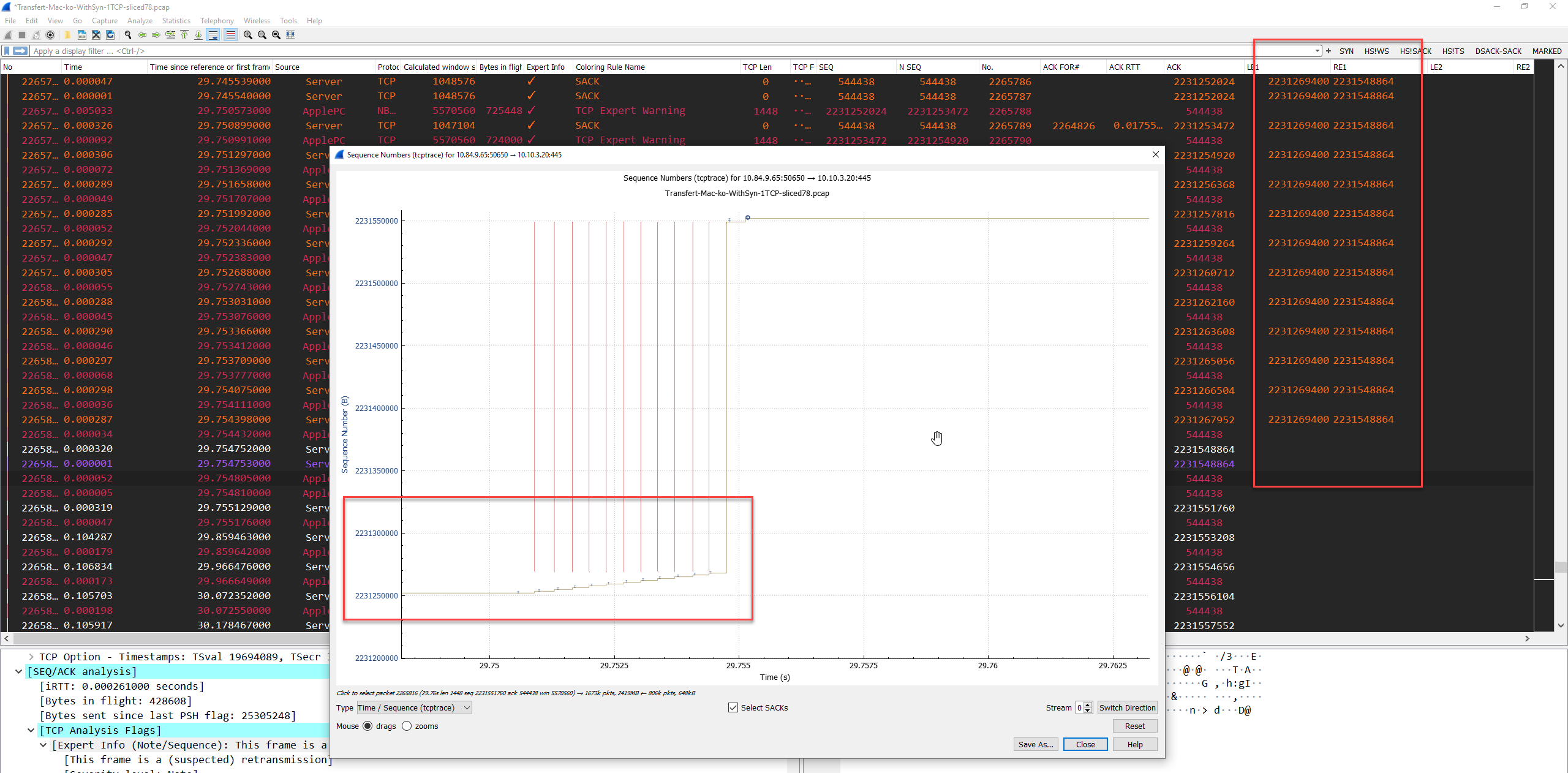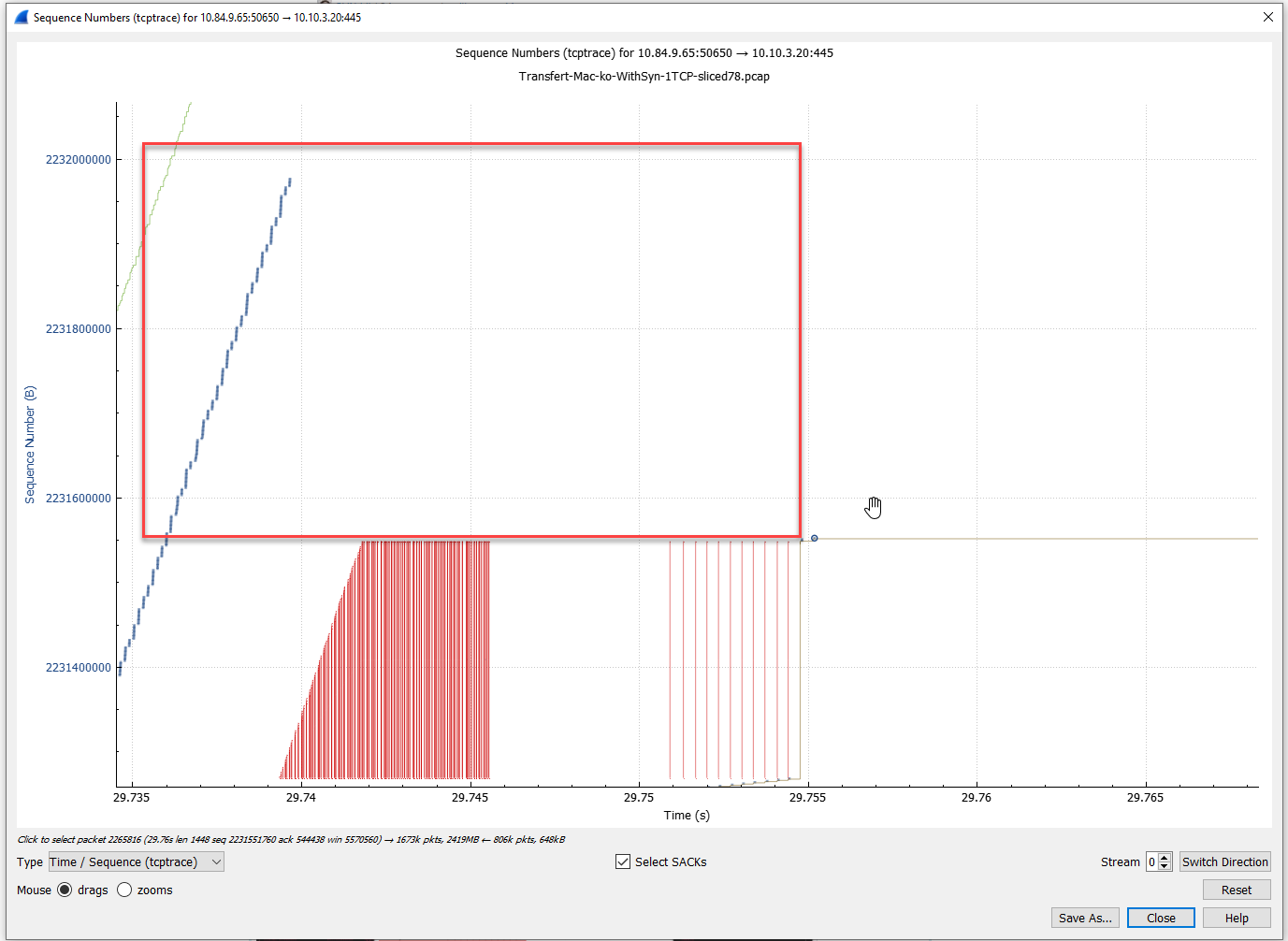 | 1 | initial version |
Here comes my try of an answer: In the screenshot the followings things can be observed:
So why is it difefrent to Windows? I have two hypothesis in mind:


 | 2 | No.2 Revision |
Here comes my try of an answer: In the screenshot the followings things can be observed:
So why is it difefrent to Windows? I have two hypothesis in mind:


 | 3 | No.3 Revision |
Here comes my try of an answer: In the screenshot the followings things can be observed:
So why is it difefrent to Windows? I have two three hypothesis in mind:


 | 4 | No.4 Revision |
Update 1: Default Congestion algorythm on mac so is cubic:
net.inet.tcp.newreno_sockets: 0
net.inet.tcp.background_sockets: 2
net.inet.tcp.cubic_sockets: 114
net.inet.tcp.use_newreno: 0
net.inet.tcp.cubic_tcp_friendliness: 0
net.inet.tcp.cubic_fast_convergence: 0
net.inet.tcp.cubic_use_minrtt: 0
Here comes my try of an answer: In the screenshot the followings things can be observed:
So why is it difefrent to Windows? I have three hypothesis in mind:


 | 5 | No.5 Revision |
Update 1:
Default Congestion algorythm on mac so is cubic:MacOS is Cubic:
net.inet.tcp.newreno_sockets: 0
net.inet.tcp.background_sockets: 2
net.inet.tcp.cubic_sockets: 114
net.inet.tcp.use_newreno: 0
net.inet.tcp.cubic_tcp_friendliness: 0
net.inet.tcp.cubic_fast_convergence: 0
net.inet.tcp.cubic_use_minrtt: 0
Here comes my try of an answer: In the screenshot the followings things can be observed:
So why is it difefrent to Windows? I have three hypothesis in mind:


 | 6 | No.6 Revision |
Update 1: Default Congestion algorythm on MacOS is Cubic:
net.inet.tcp.newreno_sockets: 0
net.inet.tcp.background_sockets: 2
net.inet.tcp.cubic_sockets: 114
net.inet.tcp.use_newreno: 0
net.inet.tcp.cubic_tcp_friendliness: 0
net.inet.tcp.cubic_fast_convergence: 0
net.inet.tcp.cubic_use_minrtt: 0
Original post:
Here comes my try of an answer: In the screenshot the followings things can be observed:
So why is it difefrent to Windows? I have three hypothesis in mind:


 | 7 | No.7 Revision |
Update 1: Default Congestion algorythm on MacOS is Cubic:
net.inet.tcp.newreno_sockets: 0
net.inet.tcp.background_sockets: 2
net.inet.tcp.cubic_sockets: 114
net.inet.tcp.use_newreno: 0
net.inet.tcp.cubic_tcp_friendliness: 0
net.inet.tcp.cubic_fast_convergence: 0
net.inet.tcp.cubic_use_minrtt: 0
Update 2:
If someone knows the following bullet points better, please correct me. All sources I have found, stated things sometimes differently so I tried to get it right connected.:
++++++++ open for discussions +++++++++++++++++++++ - Even Cubic uses the recovery algorithms of New Reno, it divers only in Congestion avoidance part. - an RTO causes cwnd=1 as long all outstanding data is recovered - cwnd=1 causes the receiver side to go into delayed ACK - the difference between the huge gap and the faster recovery times is SACK. A packet which causes a SACK have to send out immediately. - but due to the SACK problem on the server side, no SACK blocks can be reported anymore (See Sakes answer or the picture with the green rectangle below) ++++++++++++++++++++++++++++++++++++++++++++++++++
Original post:
Here comes my try of an answer: In the screenshot the followings things can be observed:
So why is it difefrent to Windows? I have three hypothesis in mind:


 | 8 | No.8 Revision |
Update 1: Default Congestion algorythm on MacOS is Cubic:
net.inet.tcp.newreno_sockets: 0
net.inet.tcp.background_sockets: 2
net.inet.tcp.cubic_sockets: 114
net.inet.tcp.use_newreno: 0
net.inet.tcp.cubic_tcp_friendliness: 0
net.inet.tcp.cubic_fast_convergence: 0
net.inet.tcp.cubic_use_minrtt: 0
Update 2:
If someone knows the following bullet points better, please correct me. All sources I have found, stated things sometimes differently so I tried to get it right connected.:
++++++++ open for discussions +++++++++++++++++++++
- can be discussed +++++++++++++++++++++
++++++++++++++++++++++++++++++++++++++++++++++++++
Original post:
Here comes my try of an answer: In the screenshot the followings things can be observed:
So why is it difefrent to Windows? I have three hypothesis in mind:


 | 9 | No.9 Revision |
Update 1: Default Congestion algorythm on MacOS is Cubic:
net.inet.tcp.newreno_sockets: 0
net.inet.tcp.background_sockets: 2
net.inet.tcp.cubic_sockets: 114
net.inet.tcp.use_newreno: 0
net.inet.tcp.cubic_tcp_friendliness: 0
net.inet.tcp.cubic_fast_convergence: 0
net.inet.tcp.cubic_use_minrtt: 0
Update 2:
If someone knows the following bullet points better, please correct me. All sources I have found, stated things sometimes differently so I tried to get it right connected.:
++++++++ can be discussed +++++++++++++++++++++
congestion avoidance state.cwnd=1 as long as all outstanding data is recovered
cwnd=1 causes the receiver side to go into delayed ACKSACK. A packet which causes a SACK have to send out immediately.
SACK problem on the server side, no SACK blocks can be reported anymore (See Sakes answer or the picture with the green rectangle below) ++++++++++++++++++++++++++++++++++++++++++++++++++
Original post:
Here comes my try of an answer: In the screenshot the followings things can be observed:
So why is it difefrent to Windows? I have three hypothesis in mind:


 | 10 | No.10 Revision |
Update 1: Default Congestion algorythm on MacOS is Cubic:
net.inet.tcp.newreno_sockets: 0
net.inet.tcp.background_sockets: 2
net.inet.tcp.cubic_sockets: 114
net.inet.tcp.use_newreno: 0
net.inet.tcp.cubic_tcp_friendliness: 0
net.inet.tcp.cubic_fast_convergence: 0
net.inet.tcp.cubic_use_minrtt: 0
Update 2:
If someone knows the following bullet points better, please correct me. All sources I have found, stated things sometimes differently so I tried to get it right connected.:
++++++++ can be discussed +++++++++++++++++++++
New Reno, it divers only in congestion avoidance state.cwnd=1 as long as all outstanding data is recovered
cwnd=1 causes the receiver side to go into SACK. A packet which causes a SACK have to send out immediately.
SACK problem on the server side, no SACK blocks can be reported anymore (See Sakes answer or the picture with the green rectangle below) ++++++++++++++++++++++++++++++++++++++++++++++++++
Original post:
Here comes my try of an answer: In the screenshot the followings things can be observed:
So why is it difefrent to Windows? I have three hypothesis in mind:


 Copyright Wireshark Foundation, 2017-2023 Content on this site is licensed under a Creative Commons Attribution Share Alike 3.0 license.
Copyright Wireshark Foundation, 2017-2023 Content on this site is licensed under a Creative Commons Attribution Share Alike 3.0 license.